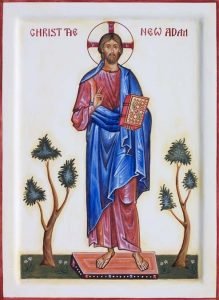 Humankind, being in God’s image and likeness, is at the heart of what it is to be human – humans are according to his image; humans are like God in some way. The Greek Fathers read Genesis in Greek, and the Greek, to an educated ear, makes two further suggestions. First, this phrase according to the image, is quite a strong preposition; it suggests the question, According to what image? The English in the image just suggests that man was created as the image of God; the Greek raises the possibility of something more complex: man created according to the image of God. Who is? The New Testaments suggests Christ, the image of God, the one who images forth God in his incarnate state. So maybe there is here, for the Christian Greek ear, the idea that humankind was created according to Christ, who is the image of the Father. This may remind one of the depiction of creation in the north portal of Chartres Cathedral, where the cruciform halo makes it evident that it is Christ who is the Creator (as the Nicene Creed affirms: ‘through whom (that is the Son) all things were made”) and in making man he makes one who is like him, who is in accordance with him. So our very creation entails a relationship, not just to God as Creator, but to Christ, the Son of God Incarnate.
Humankind, being in God’s image and likeness, is at the heart of what it is to be human – humans are according to his image; humans are like God in some way. The Greek Fathers read Genesis in Greek, and the Greek, to an educated ear, makes two further suggestions. First, this phrase according to the image, is quite a strong preposition; it suggests the question, According to what image? The English in the image just suggests that man was created as the image of God; the Greek raises the possibility of something more complex: man created according to the image of God. Who is? The New Testaments suggests Christ, the image of God, the one who images forth God in his incarnate state. So maybe there is here, for the Christian Greek ear, the idea that humankind was created according to Christ, who is the image of the Father. This may remind one of the depiction of creation in the north portal of Chartres Cathedral, where the cruciform halo makes it evident that it is Christ who is the Creator (as the Nicene Creed affirms: ‘through whom (that is the Son) all things were made”) and in making man he makes one who is like him, who is in accordance with him. So our very creation entails a relationship, not just to God as Creator, but to Christ, the Son of God Incarnate.
There is yet another point to note: verse 26 in Genesis adds this: and according to likeness. The word translated ‘likeness’, homoiosis, truly suggests something more precise in Greek: the ending –osis, implies a process, not a state (the Greek for likeness as a state would be homoioma). The word homoiosis would moreover have very definite resonances for anyone who had read Plato, who envisages the goal of the human life as homoiosis – likening, assimilation – to the divine. In the Theaetetus, Socrates remarks, in a phrase very popular among some of the Fathers: ‘flight from the world is assimilation to God so far as is possible’. So, to be created according to the image of God and according to his likeness suggests that we have been created with some kind of affinity for God which makes possible a process of assimilation to God, which is, presumably, the point of human existence.
What this all suggests is that in order to understand our faith, we must rely on Tradition (the Fathers of the Church) to truly come to a correct understanding of our faith. This all supports the Eastern Church’s spiritual idea of Theosis!
